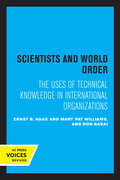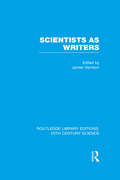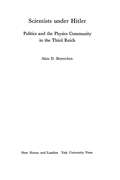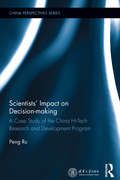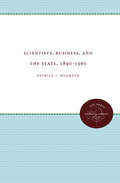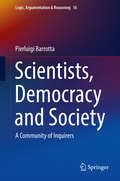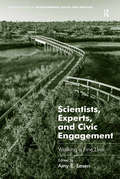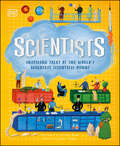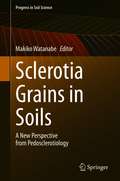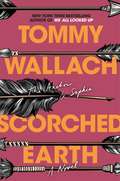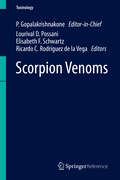- Table View
- List View
Scientists and World Order: The Uses of Technical Knowledge in International Organizations
by Ernst B. Haas Mary Pat Williams Don BabaiThis title is part of UC Press's Voices Revived program, which commemorates University of California Press’s mission to seek out and cultivate the brightest minds and give them voice, reach, and impact. Drawing on a backlist dating to 1893, Voices Revived makes high-quality, peer-reviewed scholarship accessible once again using print-on-demand technology. This title was originally published in 1977.
Scientists as Writers (Routledge Library Editions: 20th Century Science)
by James HarrisonIn the endless debate about the Two Cultures no book until this attempted to provide a selection of scientific writing on specific themes to stimulate students of arts subjects into discussion and writing about the nature of science and its relationship with the rest of life. This book is based on a selection of prose passages written by scientists about science, supplemented by notes and a brief linking commentary. Originally published in 1965, the passages were chosen to illustrate or comment on different aspects of eleven main themes, ranging from surveys of changing ideas on the nature of the universe and the material of which it was made, to evolution past and future and the relation of science with religion and art. Most of the extracts were from contemporary authors, but there are passages by Aristotle, Bacon, Boyle, Hooke, Newton, Dalton, Faraday and Darwin. At the end of the book there are suggestions for discussion to accompany each chapter, to encourage the study of the use of language in consideration of the nature, history and role of science.
Scientists at War
by Sarah BridgerSarah Bridger examines the ethical debates that tested the U.S. scientific community during the Cold War, and scientists' contributions to military technologies and strategic policymaking, from the dawning atomic age through the Strategic Defense Initiative (Star Wars) in the 1980s, which sparked cross-generational opposition among scientists.
Scientists under Hitler: Politics and the Physics Community in the Third Reich
by Alan D. BeyerchenThe treatment of German physicists under the Nazi regime had far-reaching consequences both for the outcome of the Second World War and for the course of science for decades thereafter. Although this fact has been known from a few famous episodes, it has not been dealt with thoroughly by scholars because it involves two very different disciplines. Political historians have cautiously left it to historians of science, who in turn have shied away from it out of ignorance of the political intricacies. Alan D. Beyerchen here examines this history in detail, basing his research on archival materials in Germany and the United States and on tape-recorded interviews with leading physicists. At least twenty-five percent of Germany's academic physicists who were working in 1933 lost their positions during the Nazi period. The victims -- Jews and other "politically unreliable" persons -- included some of Germany's finest scientists. Those who remained faced opposition not only from Nazi officials but also from certain members of their own community, notably the Nobel laureates Philipp Lenard and Johannes Stark. Beyerchen describes the mechanisms of prejudice, the reaction to the dismissals, and the impact of the "Aryan physics" movement which ultimately failed.
Scientists' Impact on Decision-making: A Case Study of the China Hi-Tech Research and Development Program (China Perspectives)
by Peng RuWith the increasing influence of science and technology (S&T) on socioeconomic life and public affairs, there has been a growing demand for S&T expertise in today's public decision-making. The National High Technology Research and Development Program (863 Program), involving hundreds of S&T experts, marked the beginning of a new journey for China's high-tech development. This book discusses China's S&T decision-making mechanism, with the 863 Program as the central case and scientist' influence on public decision-making as the focus. More importantly, it extracts three key elements to analyze the determinative factors behind that influence — knowledge, value and institutions, and proposed a KIV framework of macro-analysis. The KIV, being the first framework to generalize factors that could affect scientists' influence on public decision-making, is of both theoretical significance and innovative value. In addition, by finding out those factors, this book attempts to create a decision-making environment conducive to scientists' contribution of their knowledge.
Scientists, Business, and the State, 1890-1960 (The Luther H. Hodges Jr. and Luther H. Hodges Sr. Series on Business, Entrepreneurship, and Public Policy)
by Patrick J. McGrathIn the late nineteenth century, scientists began allying themselves with America's corporate, political, and military elites. They did so not just to improve their professional standing and win more money for research, says Patrick McGrath, but for political reasons as well. They wanted to use their new institutional connections to effect a transformation of American political culture. They succeeded, but not in ways that all scientists envisioned or agreed upon. McGrath describes how, between 1890 and 1960, scientific, business, and political leaders together forged a new definition of American democracy in which science and technology were presented to the public as crucial ingredients of the nation's progress, prosperity, and political stability. But as scientists became more prominent, they provoked conflicts among themselves as well as with their institutional patrons over exactly how their expertise should be used. McGrath examines the bitter battles that erupted over the role scientists should play during the Great Depression, World War II, the Cold War arms race, and the security and loyalty investigations of the 1950s. He finds that, by the end of the 1950s, scientists were regarded by the political and military elite not as partners but as subordinate technicians who were expected to supply weapons on demand for the Cold War state.Originally published 2001.A UNC Press Enduring Edition -- UNC Press Enduring Editions use the latest in digital technology to make available again books from our distinguished backlist that were previously out of print. These editions are published unaltered from the original, and are presented in affordable paperback formats, bringing readers both historical and cultural value.
Scientists, Democracy and Society: A Community Of Inquirers (Logic, Argumentation And Reasoning Ser. #16)
by Pierluigi BarrottaThis monograph examines the relationship between science and democracy. The author argues that there is no clear-cut division between science and the rest of society. Rather, scientists and laypeople form a single community of inquiry, which aims at the truth.To defend his theory, the author shows that science and society are both heterogeneous and fragmented. They display variable and shifting alliances between components. He also explains how information flow between science and society is bi-directional through “transactional” processes. In other words, science and society mutually define themselves. The author also explains how science is both objective and laden with values.Coverage includes a wide range of topics, such as: the ideal of value-free science, the is/ought divide, “thick terms” and the language of science, inductive risk, the dichotomy between pure science and applied science, constructivism and the philosophy of risk. It also looks at the concepts of truth and objectivity, the autonomy of science, moral and social inquiry, perfectionism and democracy, and the role of experts in democratic societies. The style is philosophical, but the book features many examples and case-studies. It will appeal to philosophers of science, those in science and technology studies as well as interested general readers.
Scientists, Experts, and Civic Engagement: Walking a Fine Line (Routledge Studies in Environmental Policy and Practice)
by Amy E. LesenHow do scientists, scholars, and other experts engage with the general public and with the communities affected by their work or residing in their sites of study? Where are the fine lines between public scholarship, civic engagement, and activism? Must academics 'give back' once they collect data and publish results? In this volume, authors from a wide range of disciplines examine these relationships to assess how they can be fruitful or challenging. Describing the methodological and ethical issues that experts must consider when carrying out public scholarship, this book includes a checklist for critical factors of success in engagement and an examination of the role of digital social media in science communication. Illustrated by a range of case studies addressing environmental issues (climate change, resource use, post-disaster policy) and education, it offers an investigation into the levels and ways in which scholars can engage, and how and whether academics and experts who engage in community work and public scholarship are acknowledged and rewarded for doing so by their institutions. Also bringing into the debate the perspective of citizens who have collaborated with academics, the book offers an exploration of the democratizing potential of participatory action research.
Scientists: Inspiring Tales of the World's Brightest Scientific Minds (DK Explorers)
by DKMeet the people who changed the world of science and technology, biology, chemistry and physics!Read the stories of the brainiest people who ever lived and the scientific discoveries they made. Each page illustrates a famous scientist's life and what made their contribution to this fascinating field so important. Scientists is an exciting book perfect for children ages 7-9 years. Inside you will find: • Stories of more than 50 scientists like Isaac Newton, both famous and lesser-known. • Comprehensive coverage of the most important scientific advancements of all time. • Stories of scientists from all over the world specializing in different areas of science. • Information inline with the STEAM and STREAM school curriculums. Introduce children to titans of science!The biggest scientific breakthroughs in history have something in common: super smart people who kept looking for the answers to some of the world&’s most interesting questions! The pages of this science book are filled with the stories of famous scientists like physicists Neil DeGrasse Tyson and Stephen Hawking, biologist Marie Curie, paleontologist Mary Anning, and lesser-known trailblazers like Chika Kuroda, who became Japan's first female Bachelor of Science.Filled with great detail and following a storytelling format, this is a thrilling book that will capture the imagination of young children and encourage them to explore the world of science. Beautiful descriptions of the scientists' lives are brought to life through stunning watercolor illustrations, and fantastic photography highlights the detail of their discoveries.Discover more stories!Follow the stories of some of the greatest people the world has ever known. DK&’s Scientist, Explorers, and Inventors captures the genius of people who have changed history, answered important questions and made our lives easier.
Scintillation Dosimetry (Imaging in Medical Diagnosis and Therapy)
by Sam Beddar Luc BeaulieuScintillation Dosimetry delivers a comprehensive introduction to plastic scintillation dosimetry, covering everything from basic radiation dosimetry concepts to plastic scintillating fiber optics. Comprised of chapters authored by leading experts in the medical physics community, the book: Discusses a broad range of technical implementations, from point source dosimetry scaling to 3D-volumetric and 4D-scintillation dosimetry Addresses a wide scope of clinical applications, from machine quality assurance to small-field and in vivo dosimetry Examines related optical techniques, such as optically stimulated luminescence (OSL) or Čerenkov luminescence Thus, Scintillation Dosimetry provides an authoritative reference for detailed, state-of-the-art information on plastic scintillation dosimetry and its use in the field of radiation dosimetry.
Sclerotia Grains in Soils: A New Perspective from Pedosclerotiology (Progress in Soil Science)
by Makiko WatanabeThis book introduces what sclerotia grains are, and where and how they exist in soils, by compiling the results obtained from the studies on fungal sclerotia formed by Cenococcum geophilum (Cg) and related species, the visible black small grains persistent for a few thousand to ten thousands of years in forest soils and sediments. The chapters contain the results and discussions on the ecological distribution and regulating factors, characteristics, and function of Cg sclerotia grains, carried out by researchers from soil geography, soil science, soil microbiology, physiology, forestry, analytical chemistry, environmental chemistry, material science, and related disciplines. The anatomy of sclerotia grains in soil was realized in terms of interdisciplinary joint researches, which resulted in deepening understanding of the ecological function of the mesoscale organic component in soils. This book covers the natural history of sclerotia in soils, pedo-sclerotiology.
Scorched Earth (The Anchor & Sophia #3)
by Tommy WallachFrom the New York Times bestselling author of We All Looked Up comes the exciting conclusion to the &“haunting…beautiful and heartbreaking&” (School Library Journal) Anchor & Sophia trilogy, where the rules of humanity come to a head in the final battle between two warring cities.In this thrilling conclusion to the Anchor & Sophia trilogy, the great war has finally begun. The Descendancy must fight for its survival against not only the Sophian army, but a Wesah nation newly galvanized by the Black Wagon Massacre. And four young people will once again find themselves at the center of the maelstrom. Accused of a crime she didn&’t commit, Paz Dedios is on the run from the law...and the man she loves. Traumatized by the near-genocide of her people and the death of her lover, Athène is bent on revenge. Newly reunited in the Anchor, Clive and Clover Hamill will struggle to come to terms with the reappearance of a ghost from the past. Who will win the war for the future? And who will be left standing when it&’s all over?
Scorpion Venoms
by P. Gopalakrishnakone Lourival D. Possani Elisabeth F. Schwartz Ricardo C. Rodríguez de la VegaIn recent years, the field of Toxinology has expanded substantially. On the one hand it studies venomous animals, plants and micro organisms in detail to understand their mode of action on targets. While on the other, it explores the biochemical composition, genomics and proteomics of toxins and venoms to understand their three interaction with life forms (especially humans), development of antidotes and exploring their pharmacological potential. Therefore, Toxinology has deep linkages with biochemistry, molecular biology, anatomy and pharmacology. In addition, there is a fast developing applied subfield, clinical toxinology, which deals with understanding and managing medical effects of toxins on human body. Given the huge impact of toxin-based deaths globally, and the potential of venom in generation of drugs for so-far incurable diseases (for example, Diabetes, Chronic Pain), the continued research and growth of the field is imminent. This has led to the growth of research in the area and the consequent scholarly output by way of publications in journals and books. Despite this ever growing body of literature within biomedical sciences, there is still no all-inclusive reference work available that collects all of the important biochemical, biomedical and clinical insights relating to Toxinology. The Handbook of Toxinology aims to address this gap and cover the field of Toxinology comprehensively.
Scott Foreman Science (Grade 2, Texas edition)
by Timothy Cooney Karen L. Ostlund Michael Anthony Dispezio Barbara K. Foots Kate Boehm Nyquist Angie L. MatamorosScientists use scientific methods to find answers to questions. Scientific methods have the steps shown on these pages. Scientists sometimes use the steps in different order. You can use these steps for your own science inquiries.
Scott Foreman Science: Life Science (Grade #4)
by Scott ForesmanA book which tells you how to classify living things.
Scott Foresman California Science
by Pearson EducationThis Scott Foresman California Science 5 contains units on Physical Sciences, Life Sciences and Earth Sciences.
Scott Foresman California Science (Grade #4)
by Pearson EducationThis edition contains study materials on Physical Sciences, Life Sciences and Earth Sciences.
Scott Foresman California Science (Grade 3 Giraffe)
by Scott ForesmanThe contents of Scott Foresman California Science Grade 3 Giraffe are: Unit A Physical Sciences, Unit B Life Sciences, and Unit C Earth Sciences.
Scott Foresman Earth Science
by Jay M. Pasachoff Timothy M. Cooney Naomi PasachoffIn studying earth science, you will learn about the land, water, and air that make up the planet on which we live. This textbook will help you become acquainted with this world and other worlds in space.
Scott Foresman Elementary Science 2003C Life Science
by Scott ForesmanScott Foresman Science: Life Science is for Grade 5 students.
Scott Foresman Life Science
by Ann Collins Irwin L. Slesnick Levon Balzer Phyllis L. Goodson Lois Lauer Gretchen M. AlexanderLife science is a way of finding out about living things. This textbook helps students study and understand about the living things constructively.
Scott Foresman Science
by Timothy Cooney Karen L. Ostlund Michael Anthony Dispezio Barbara K. Foots Kate Boehm Nyquist Angie L. MatamorosScientists try to solve many problems. Scientists study problems in different ways, but they all use scientific methods to guide their work. Scientific methods are organized ways of finding answers and solving problems. Scientific methods include the steps shown on these pages. The order of the steps or the number of steps used may change. You can use these steps to organize your own scientific inquiries.
Scott Foresman Science
by Timothy Cooney Karen L. Ostlund Michael Anthony Dispezio Barbara K. Foots Kate Boehm Nyquist Angie L. MatamorosScientists try to solve many problems. Scientists study problems In different ways, but they all use scientific methods to guide their work. Scientific methods are organized ways of finding answers and solving problems. Scientific methods include the steps shown on these pages. The order of the steps or the number of steps used may change. You can use these steps to organize your own scientific inquiries.
